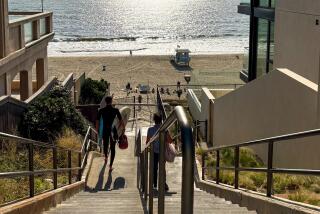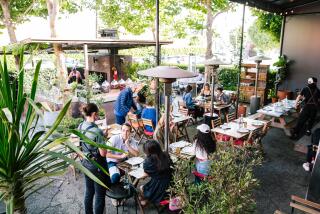Notting Like It
LONDON — When I first moved to London six years ago, friends were surprised when I told them some of my favorite hangouts were in Notting Hill, the small enclave north of the very established neighborhood of Kensington. “Oh, I’ve never been up that way,” was the usual response. “Isn’t it kind of rough around there?”
While it’s true that Notting Hill has something of a checkered past, mostly in the northern sections toward Ladbroke Grove, in recent years the neighborhood has become one of the most popular residential quarters in the city. It’s hard to find the words “Notting Hill” unaccompanied by the words “hip” and “trendy.” Now when I tell friends I spend a lot of time in Notting Hill, the response is more likely to be, “have you tried the new coffee shop?”
Few tourists discover the delights of Notting Hill, most likely because no traditional attractions are here. But a day here is for wandering around leafy streets, through eclectic shops and hanging out in cafes to watch the world go by.
Boundaries of the neighborhood vary according to whom you talk to, even within the local planning office. The dimensions have grown increasingly elastic as more people seek a W11 zip code on their letterhead, but the outline is roughly from Notting Hill Gate in the south, to Westbourne Park Road in the north, and from Lansdowne Road in the west to Chepstow Road in the east.
In many ways, Notting Hill is a microcosm of England and its extremely stratified class system. Within a very small geographical area, inhabitants range from well-heeled English society to those who scrape by on government subsidies. It’s a place where $16,000 bracelets are on sale just a few blocks from one of the poorest subsidized housing developments in London.
Contrast is embedded in Notting Hill’s history. In the 1800s, most residents were employed to build and work in the wealthy homes being built to the west around Lansdowne Road. These streets now boast some of London’s most elegant homes.
*
The neighborhood’s most famous street, Portobello Road, has a long tradition of housing immigrants, beginning with Jewish and Irish settlers in the 19th century and more recently, large Spanish, Portuguese and Moroccan communities.
In the 1950s, West Indians came into a pressurized community suffering from an acute housing shortage. Some white residents resented the additional competition for jobs and housing and in the summer of 1958, gangs of white youths attacked Caribbean houses and people. The black community fought back, sparking four days of sporadic fighting. But things have calmed down considerably in recent years. The Notting Hill Carnival--now the largest street festival in Europe--was started by a social worker in 1965 partly in an effort to unite the community.
Although residents tout Notting Hill’s ethnic mix as one of its principal attractions, as housing prices have soared, faces are becoming more mainstream. The foreigners that bring Notting Hill its vitality are slowly moving northward as young professionals pay more than $160,000 for small apartments on the northern fringes of Notting Hill.
But even the money here has a different flavor than in the nearby residential neighborhoods of Kensington and Chelsea. Notting Hill residents thrive on the buzz of eclecticism. The neighborhood still has an element of funkiness that entices an offbeat crowd. The bohemian character is maintained partly by an abundance of writers, artists and media executives. And of course a smattering of celebrities never hurts. Tina Turner, actress Theresa Russell, Jade Jagger and Brian Eno have called Notting Hill home in recent years.
For a glimpse of how the privileged live in London, including actor Alan Rickman, CNN correspondent Christiane Amanpour, playwright Christopher Hampton and musician Peter Gabriel, begin a Notting Hill tour on Ladbroke Grove. After exiting the Notting Hill Gate tube, walk west, make a right on to Ladbroke Grove and walk up the hill.
Purists define Ladbroke Grove as Notting Hill’s westernmost boundary because this is the Notting Hill. The summit, by St. John’s Church, is where spectators stood in 1837 to watch horse races at the Hippodrome racecourse that circled the hill. When the race track failed four years later, the Ladbroke Estate began to be developed with the grand Georgian homes that now exist west of Kensington Park Road and about as far north as Elgin Crescent. “Leafy Ladbroke” spread gradually to include Pembridge Square and Villas and Chepstow Villas and Crescent.
The elegant street plans envisioned by planners were not completed because there was not enough demand for expensive homes. “The houses were left derelict and many were subdivided into flats or rooms before they were occupied,” explains Barbara Denny, a local historian. “As Notting Hill has become fashionable, these homes have been restored and become fashionable with it.” The grandest homes are on Lansdowne Road and Crescent and surround Ladbroke Square.
“Kensington and Chelsea for the most part were always rich,” Denny says. “But Notting Hill’s affluence is a relatively recent thing, beginning in the late ‘50s when money became available for property development after World War II.” The enthusiasm has been fueled in part by two world-famous attractions: the Notting Hill Carnival and the Portobello Road Market. Carnival takes place every year during the last weekend of August at the northern end of Portobello Road and vicinity. Based on the Trinidad street Carnival, the Notting Hill version features parades with huge floats, outrageous costumes, calypso and steel drum bands to which everyone dances, and lots of Caribbean food. Carnival now attracts more than 2 million visitors, which ironically inspires many locals to lock up their houses and flee to the country during the festivities.
*
Portobello Market is one of the largest street markets in the world with about 2,000 traders in pavement stalls, arcades and shops. The market begins at the top of Portobello, off Pembridge Road by Notting Hill Gate, and runs virtually the entire length of the road.
On Saturdays, the antiques are out by 5:30 a.m. Regulars know this is the best time to go for first dibs on the best merchandise. By mid-morning, the narrow street is jammed with sellers, buyers and onlookers just wanting to be part of the scene.
The best antiques are located near the Notting Hill Gate end of the road. As you descend the hill, the wares become more like bric-a-brac, but the fun of Portobello is that you never know what you’ll find. At the northern end, beneath the gloomy arches of the Westway (the elevated A40 motor way), an extremely popular flea market reigns on Saturdays. Unless you’re a flea market aficionado, you won’t find much to spend your money on but it’s worth walking this far just to absorb the local color.
Midway along Portobello Road, starting at Colville Terrace, the fruit, vegetable and flower stands are open every day. Amid the aroma of sizzling bratwurst and schnitzel from food stalls, fruit sellers call out their bargains. “Best bah-nan-as here . . . that’s a nice bit of tomato, love.”
In warm weather, an ideal vantage point for marketplace action is from the upstairs terrace of Cafe Grove on the corner of Lancaster Road. In the evening, across the street, the expansive Market Bar has an inviting atmosphere with plush drapes, huge dried flower arrangements and an open fire in winter. The Ground Floor Bar by Talbot Road is another good rest stop with huge windows overlooking the market.
Although the Saturday bustle has brought Portobello Road worldwide fame, the charms of this winding street are more visible on weekdays when the roadside stalls are empty but many antique shops and cafes are open. This is when it’s a lot easier to imagine bygone days of the Lane, as locals call it.
Just off Portobello Road by the fruit market, the small section of Blenheim Crescent has three of the best specialty bookshops in London. At No. 4, Books for Cooks is well-known internationally among professional chefs, caterers and serious gourmands for its huge collection of cookbooks, catering texts and menu planners. If a book is not on the shelf, the enthusiastic staff will do their best to obtain it.
In the past few years, this unassuming little shop has become a popular lunch spot--so much so that now you need reservations to be assured one of the five small tables. Every weekday, chefs try out recipes from the vast collection of books lining the walls. Mid-morning or afternoon, you can stop by for a cup of tea or coffee, piece of cake and a chat about the books.
*
Across the street, the Travel Bookshop does for those with wanderlust what Books for Cooks does for foodies. Travel guides, literature, maps and atlases cover just about every square inch of the world. Next door at No. 11, gardeners will enjoy selections ranging from “Sam Plants a Sunflower” to “A Little Light Weeding” at Garden Books. There are numerous other interesting shops in the vicinity including Graham & Green for home wares, the Spice Shop for a tremendous variety of spices and Siola on Kensington Park Road, which stocks clothes and fabrics from India.
A major component of Notting Hill’s transition to a hot hangout has been the arrival of numerous bars and top-notch restaurants. The food revolution began in 1982 at the restaurant 192 on Kensington Park Road. Although it’s no longer the “place to be seen,” there are still plenty of mirrors for viewing the beautiful people, and the modern British food holds its own. In warm weather, there are a few sidewalk tables. Across the street, Osteria Basilico serves healthy portions of pasta with very reasonable prices for London.
On the same block of Kensington Park Road, Cafe Med, with its blend of steel, wood, mirrors, candles and leather armchairs, is a cozy spot to begin the night with a drink. Grilled meats are a good bet.
Not too far away from 192, the restaurant’s first chef, Alistair Little--now one of Britain’s most celebrated cooks--has a restaurant named after himself on Lancaster Road. The Mediterranean cooking is superb. An even more popular choice of late is the Sugar Club, where New Zealander Peter Gordon deliciously combines Pacific Rim ingredients. Neither of these restaurants is technically in Notting Hill but they are worth the short detour.
For traditional, highly respected food in the center of the neighborhood, Leith’s, at the southern end of Kensington Park Road, offers a more formal (and more expensive) setting. A good way to experience the modern British cuisine here is lunch with a set price menu. Around the corner, on Ledbury Road, Beach Blanket Babylon provides a memorable dining experience in Gaudi-esque surroundings. People tend to say that the Mediterranean food doesn’t live up to the surroundings. In the vicinity, Assagi, above the Chepstow pub, serves authentic Italian food in a colorful setting.
A number of Notting Hill pubs have had face lifts in the past few years. Three of the best are on the eastern fringes of the neighborhood, toward Bayswater. The Cow has the most traditional decor, modeled on a cozy Irish bar. Seafood is the specialty but get here early because the barroom tables go quickly. Across the street on Westbourne Park Villas, the Westbourne is a large, open space with mirrors and lots of clean wood. The refined British food is tasty. A few streets to the south, critics commend the food at the Prince Bonaparte.
Right now everyone in Notting Hill is talking about the Pharmacy. This is not where you come for your pharmaceutical needs. The upstairs dining room is dominated by a sculpture of DNA crafted by Damien Hirst, and waiters are clad in surgical gowns (designed by Prada). Downstairs, bartenders stand beneath a giant portrait of pills and serve drinks called Cough Syrup and Voltarol Retarding Agent. A bit bizarre, but so very Notting Hill.
(BEGIN TEXT OF INFOBOX / INFOGRAPHIC)
GUIDEBOOK
Up, Down the ‘Hill’
Getting there: There’s nonstop service LAX-London on British Airways, Virgin Atlantic, Continental code-sharing with Virgin, United, American and Air New Zealand; round-trip fares begin at about $520 including taxes.
Where to stay: Most lodgings in Notting Hill are smaller, non-chain hotels with expensive tabs. For better rates, try larger hotels in Holborn or even Kensington.
Abbey Court Hotel, 20 Pembridge Gardens, London W2 4DU; telephone 011-44-171-221-7518. Deep red wallpaper and antiques make this 22-room townhouse hotel feel Victorian but the modern bathrooms feature Italian marble. No restaurant but 24-hour room service for light meals. Singles from about $160, doubles from $230, including VAT and continental breakfast.
Pembridge Court Hotel, 34 Pembridge Gardens (right by Underground’s Notting Hill Gate station), London W2 4DX; tel. 011-44-171-229-9977. Small, informal 20-room hotel in restored 19th century house. Singles from about $200, doubles from $285 including VAT and breakfast.
Portobello Hotel, 22 Stanley Gardens, London W11 2NG; tel. 011-44-171-727-2777. Often described as “eccentric,” this 23-room hotel in two adjoining Victorian townhouses is popular with rock stars and models. Basement bar and restaurant. Singles from $200, doubles from $270, including VAT and continental breakfast.
The Halcyon Hotel, 81 Holland Park Road, London W11 3RZ; tel. 011-44-171-727-7288. Super chic; this is where the celebs stay. 43 elegant rooms are noted for their very individual decor. The Room at the Halcyon is one of London’s finest restaurants. Singles from $120, doubles from $465, VAT included.
For more information: British Tourist Authority, 551 Fifth Ave., Suite 701, New York, NY 10176-0799; tel. (212) 986-2200, fax (212) 986-1188 or (800) GO2 BRITAIN.
More to Read
Sign up for The Wild
We’ll help you find the best places to hike, bike and run, as well as the perfect silent spots for meditation and yoga.
You may occasionally receive promotional content from the Los Angeles Times.






